AMD Ryzen 5 3600 Review: Why Is This Amazon's Best Selling CPU?
by Dr. Ian Cutress on May 18, 2020 9:00 AM ESTCPU Performance: Encoding Tests
With the rise of streaming, vlogs, and video content as a whole, encoding and transcoding tests are becoming ever more important. Not only are more home users and gamers needing to convert video files into something more manageable, for streaming or archival purposes, but the servers that manage the output also manage around data and log files with compression and decompression. Our encoding tasks are focused around these important scenarios, with input from the community for the best implementation of real-world testing.
All of our benchmark results can also be found in our benchmark engine, Bench.
Handbrake 1.1.0: Streaming and Archival Video Transcoding
A popular open source tool, Handbrake is the anything-to-anything video conversion software that a number of people use as a reference point. The danger is always on version numbers and optimization, for example the latest versions of the software can take advantage of AVX-512 and OpenCL to accelerate certain types of transcoding and algorithms. The version we use here is a pure CPU play, with common transcoding variations.
We have split Handbrake up into several tests, using a Logitech C920 1080p60 native webcam recording (essentially a streamer recording), and convert them into two types of streaming formats and one for archival. The output settings used are:
- 720p60 at 6000 kbps constant bit rate, fast setting, high profile
- 1080p60 at 3500 kbps constant bit rate, faster setting, main profile
- 1080p60 HEVC at 3500 kbps variable bit rate, fast setting, main profile
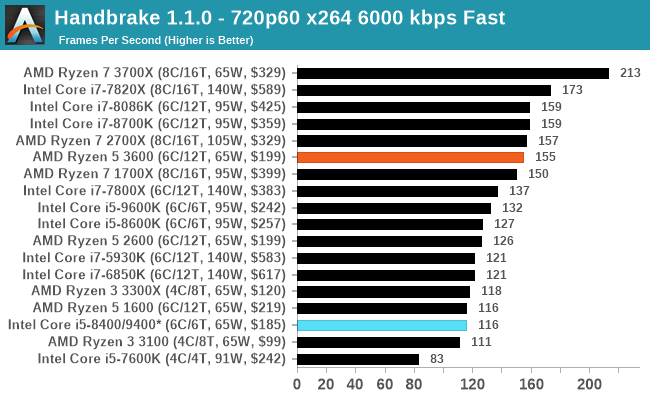
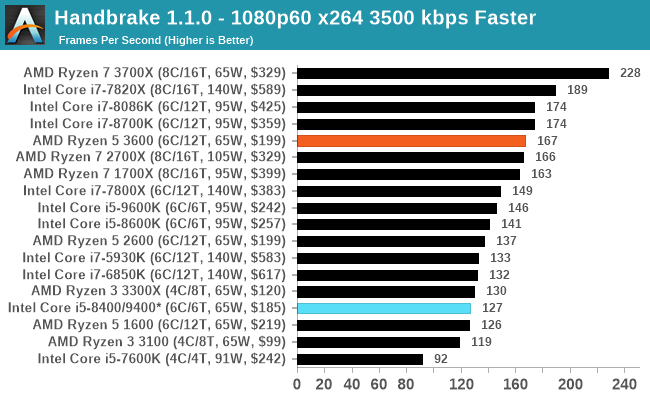

7-zip v1805: Popular Open-Source Encoding Engine
Out of our compression/decompression tool tests, 7-zip is the most requested and comes with a built-in benchmark. For our test suite, we’ve pulled the latest version of the software and we run the benchmark from the command line, reporting the compression, decompression, and a combined score.
It is noted in this benchmark that the latest multi-die processors have very bi-modal performance between compression and decompression, performing well in one and badly in the other. There are also discussions around how the Windows Scheduler is implementing every thread. As we get more results, it will be interesting to see how this plays out.
Please note, if you plan to share out the Compression graph, please include the Decompression one. Otherwise you’re only presenting half a picture.
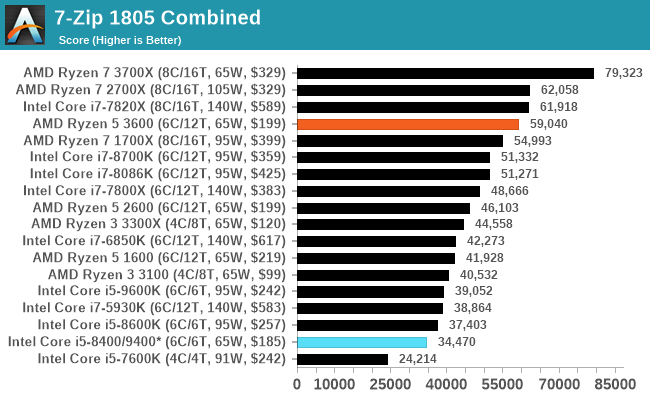
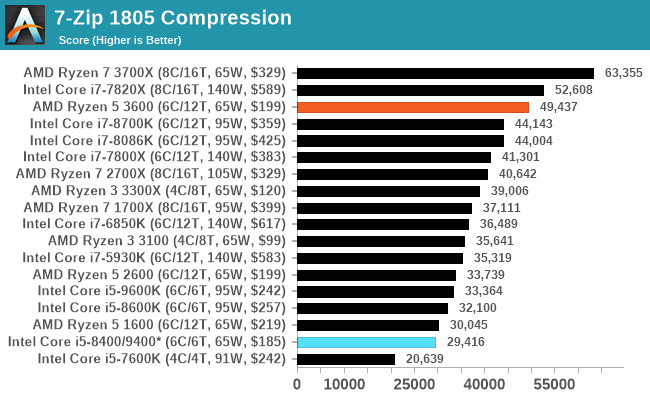
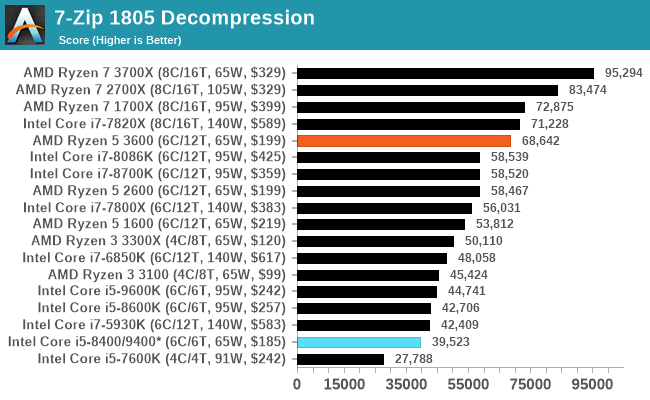
WinRAR 5.60b3: Archiving Tool
My compression tool of choice is often WinRAR, having been one of the first tools a number of my generation used over two decades ago. The interface has not changed much, although the integration with Windows right click commands is always a plus. It has no in-built test, so we run a compression over a set directory containing over thirty 60-second video files and 2000 small web-based files at a normal compression rate.
WinRAR is variable threaded but also susceptible to caching, so in our test we run it 10 times and take the average of the last five, leaving the test purely for raw CPU compute performance.
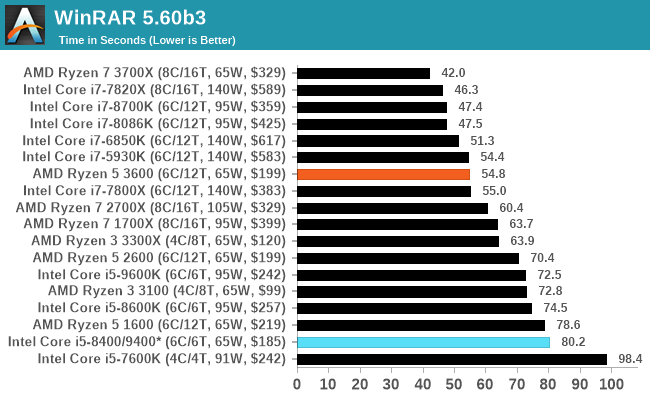
AES Encryption: File Security
A number of platforms, particularly mobile devices, are now offering encryption by default with file systems in order to protect the contents. Windows based devices have these options as well, often applied by BitLocker or third-party software. In our AES encryption test, we used the discontinued TrueCrypt for its built-in benchmark, which tests several encryption algorithms directly in memory.
The data we take for this test is the combined AES encrypt/decrypt performance, measured in gigabytes per second. The software does use AES commands for processors that offer hardware selection, however not AVX-512.
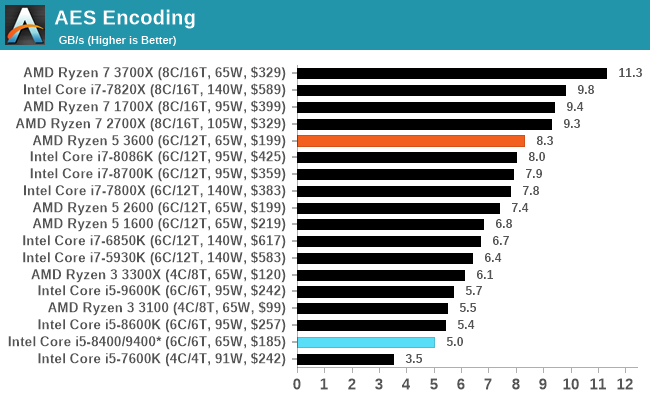










114 Comments
View All Comments
eastcoast_pete - Monday, May 18, 2020 - link
Thanks Ian!While this is not important for many (most?) readers here, I would like to see AMD or anyone else putting a more basic GPU (under $ 50 retail) out that has HDMI 2.0a or better, display port out, and that has ASICs for x264/265 and VP9 decoding; AV1 would be a plus. This could be a PCIe dGPU or something directly soldered into a MB. Am I the only one who's find that interesting? I don't like to always have to plug a high-powered dGPU into each build that has more than just an entry level CPU, so this would help.
Spunjji - Tuesday, May 19, 2020 - link
You'll likely be waiting a while. You'd need to wait for the next generation of GPUs with new display controllers and video decoders. There's a rumour that Nvidia will be producing an Ampere "MX550" for mobile, which could mean a dGPU based on the same chip being released for ~$100. Give that a couple more years to drop in price and, well, by then you'll probably want new standards. :DPgndu - Monday, May 18, 2020 - link
I come here for a clearer perspective more than benchmarks, but the timing of this article is weird, especially since 10th Gen's at the door. I get the market or Atleast pc builder cause and effect but market just got blown out of proportions with options, what actually transfers to general populace is not clear until OEM's embrace the reality like nividiaArbie - Monday, May 18, 2020 - link
"The Core i5-10500 ... is 65 W, the same as AMD".Anandtech knows very well that Intel TDP is not the same as AMD TDP. Please stop falling into the noob-journo trap of simply repeating the Intel BS just because it's official BS.
GreenReaper - Monday, May 18, 2020 - link
In fairness, TMD is also turboing to 88W, with cores plus uncore measured as taking significantly more than 65W.Spunjji - Tuesday, May 19, 2020 - link
Absolutely right, but also in fairness, Intel's sole enhancement for the 10 series appears to be enabling higher clock speeds - and they're made on the same process with the same architecture as the 9 series, which inevitably means more power will be required to reach those higher clocks.So, it's likely to be either a CPU with similar real power use to the AMD processor that never really hits its rated turbo clocks, or a CPU that does hit its rated turbo and never drops below ~100W under sustained load. It's likely to be power and speed competitive on an either/or basis, but not both at the same time.
watzupken - Tuesday, May 19, 2020 - link
This is true that its going above its TDP to provide the boost speed. However this is a practice that Intel has practiced since its Kaby Lake/ Coffee Lake series. Unfortunately, they are the worst violator when it comes to exceeding the supposed TDP when you consider how much power it is pulling to sustain its boost (PL2) speed. If you consider the boost speed of the Comet Lake, even the supposed 65W i5 10xxx series is not going to keep to 65W given the boost speed of up to 4.8Ghz, though nothing is mentioned about the all core turbo, but should be somewhere close, i.e. 4.2 to 4.6Ghz is my guess.lakedude - Monday, May 18, 2020 - link
I assume no one has mentioned the typo since it is still there."Competition
With six cores and twelve threads, the comparative Intel options vary between something like the Core i7-9600KF with six cores and no hyperthreading..."
Gotta be i5, right?
Kalelovil - Tuesday, May 19, 2020 - link
@Ian CutressThere appears to be a mistake in the AI Benchmark results, the Ryzen 5 3600 Combined result is less than the sum of its Inference and Training results.
xSneak - Tuesday, May 19, 2020 - link
Disappointed to see the continual cpu reviews using a GTX 1080 as the gpu. We would be better able to evaluate cpu performance if a 2080 ti was used given it is cpu bottlenecked at 1080p on some games. Hard to believe one of the biggest tech sites is using such under powered hardware.